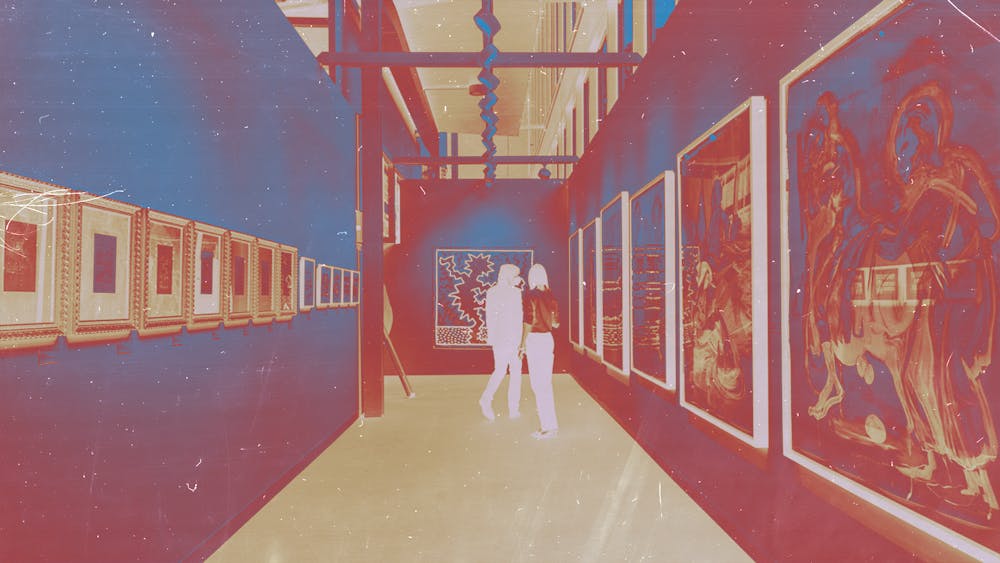BASEL, Switzerland—What are the telltale signs that someone’s made it? Is it inscribed in the way they dress, their choice of silk scarf, or seasonal handbag? Or if wealth truly whispers, it might be in the way a person carries herself—head high, shoulders low, unperturbed calm. It might be something else entirely, some mixture of pedigree and learned etiquette. But when I found myself shoulder to shoulder with the world’s most well–heeled art collectors, there was another question on my mind: Can you fake it?
Every summer since ‘70, the sleepy Swiss city of Basel transforms into the stomping ground of the rich and famous. Hundreds of bluechip galleries—mainly from New York, London, and Paris—bring their very best selection to sell. Attendees range from high–power industry executives to members of the British royal family. Leonardo DiCaprio, a noted Basquiat enthusiast, is a regular at the fair’s Miami spinoff. But the crowd here in Switzerland consists mainly of people you’ve never heard of, all the hands that quietly steer the global economy while us mortals sleep.
Walk along one of these aisles and you’ll hear a lot of shoptalk and amusing back–and–forth. Near the Zwirner booth, one Frenchman quipped to another, "Mais là, tu vas en prison!" But it’s not all business. In another booth, an American buyer gestured at his wife to examine a pair of mobiles: "Oh, these Calders are just adoooorable." That’s Alexander Calder, pioneering sculptor of the 20th century. No biggie.
Add to these crowds one more globetrotting European with a double–barreled name. Just what are my credentials? I may not come from landed gentry, but I have all the would–be might of the Fourth Estate. I’ve also been told I have an "aristocratic nose." That’s definitely a euphemism for "inbred," but all the better. Another feather in my cap at Art Basel, which might be the place you’re most likely to meet a Habsburg scion.
I expected to go largely unnoticed as I arrived for press previews on June 13, slipping past the VIP line to enter through the media and exhibitors' entrance. On my way in, I saw a very polished lady in stilettos strolling hand in hand with her Italian suit.
"Oh my God," I thought. "Can you believe this yokel?"
Tut–tut. Think of Art Basel like IKEA shopping for the caviar crowd. Weathering four to six hours in an overcrowded warehouse is no mean feat, no matter how pretty the paintings. Do that in heels and you’ll end up with bunions to match the Bernese Alps. Even this first–timer knew better.
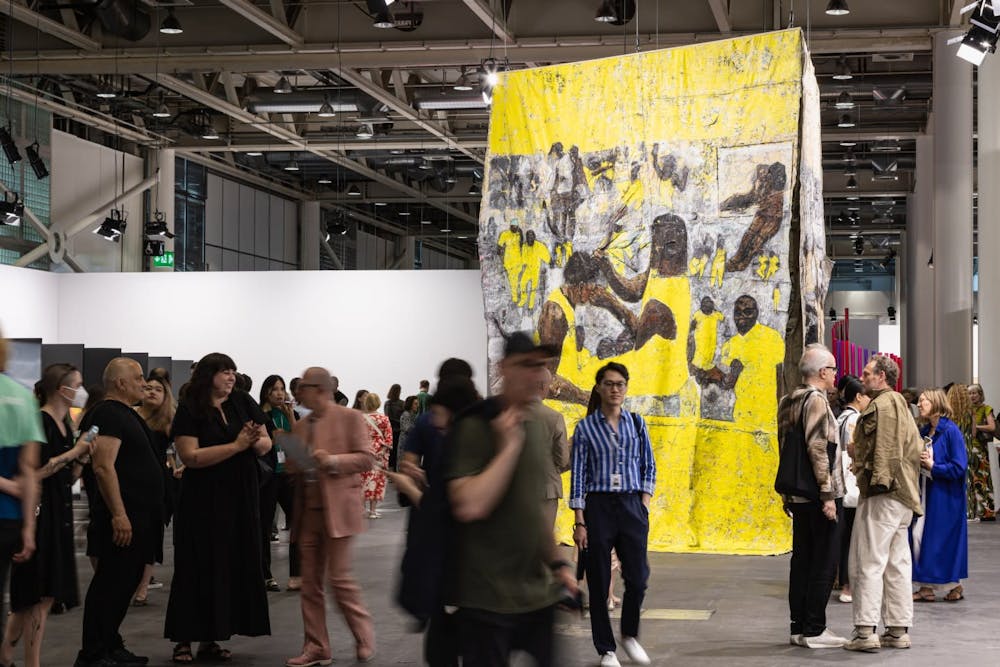
Art Basel in Basel 2023. Courtesy of Art Basel.
Inside, I soon learned the typical art fair has a few staple characters, from the Lockheed execs to the St. Gallen Stepford wives. But most buyers are small fries compared to the "mega–collectors," whose collections could probably stock a private museum or an army hangar.
Then there are the elusive gallerinas, the entry–level attendants who are just as likely to be caught rolling spliffs in Messeplatz as they are behind the booth. The typical gallerina is fashionable, aloof, and immediately forgettable. There aren’t too many at this level: Nobody trusts a nobody to broker a deal on a masterpiece. I knew I had found my kin when a middle–aged woman mistook me for one and invited me to cut the bathroom line. "You, please go ahead—you’re an exhibitor, no?" Disabuse her I did not.
At the media conference, a panel of Basel organizers and partner executives from UBS ease our worries about the jumpy state of the market, the fair’s expanding international ventures, and the Credit Suisse takeover. When one reporter throws a hardball about climate change, CEO Noah Horowitz easily defuses it.
The post–conference reception involves rotating platters of Ruinart champagne and tartare canapés. I bumble my way through a conversation with a Parisian staffer from the New York Times until we land on a topic of mutual interest: Picasso’s big bicentenary, and the accompanying divide in public opinion. I’m confronted with my own dowdy tastes—unfortunately, I love the guy.
By now slightly intoxicated, I rejoin the teeming hordes in the showroom. The art this year tends toward the earthly. A dozen Giuseppe Penones—and just as many knockoffs—dot the walls. Scattered throughout the fair, you’ll find hand–carved wooden chests, threadbare canvases, and rough–hewn metal sculptures. Arte Povera is in again, and none too soon.
The movement sprang out of Italy in the late ‘60s and sought a return to humble materials, craftsmanship, and nature. Its revival at Basel follows a spate of related exhibitions, from the Philadelphia Museum of Art’s Penone show, to Roma/New York at David Zwirner, to Lucio Fontana at Hauser & Wirth. What may seem like an austere mode feels appropriate given ongoing economic downturn and war in Europe.
There’s also no shortage of botanical motifs. The infamous Kusama pumpkins, equally suited to the carnival fairground and the art fair, are on display. As expected, climate change is high on the agenda. Our heating planet is the central concern of a number of video installations, textile installations, and, of course, the showroom’s central air–conditioning installation. But the approach is split between soothing and stoking our pulsing ecological anxieties. Artists like Firelei Báez and Adel Abdessemed sound the alarm even as the fair itself, with its traveling circus business model, takes an airy attitude.
While Art Basel doesn’t publicly share any emissions data, one can imagine the toll of bringing together 284 galleries from 36 countries. As for the tens of thousands of visitors, a sizable share travel by private jet. The mismatch between the fair’s eco–conscious posturing and its elite cachet is obvious.
But this dissonance also feels peculiar to our Zeitgeist. A 24–hour news cycle has us bouncing from crisis to crisis with no relief, all while inequality steadily deepens in the world’s most advanced economies. In an age of diminishing expectations and rising political turmoil, we’re equal parts resigned and recalcitrant.
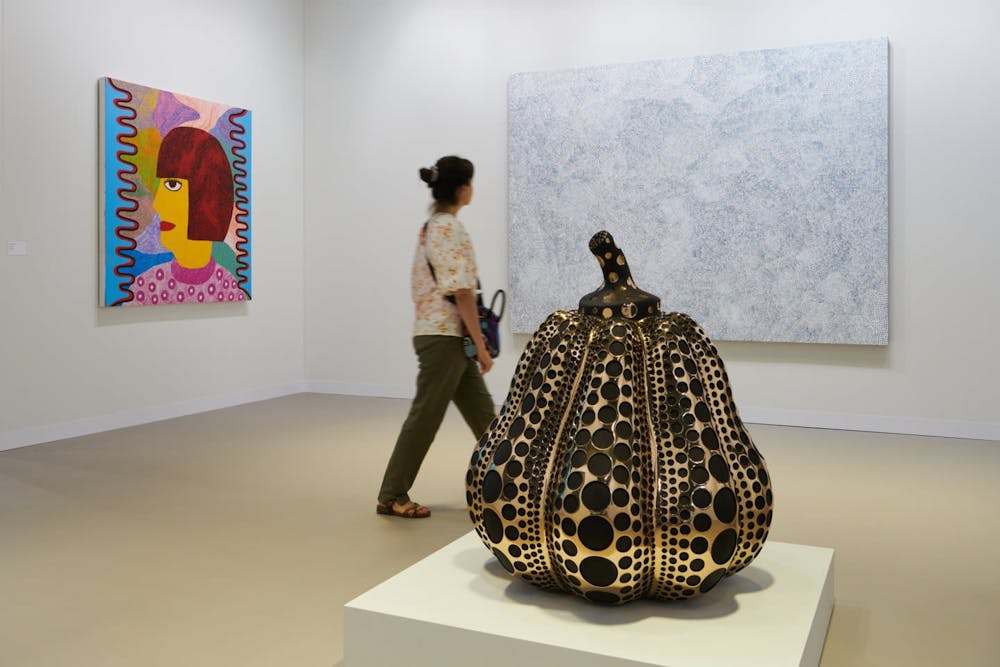
David Zwirner. Courtesy of Art Basel.
Caught between fish–eyed disaffection and heaving despair, we all care deeply about anything and everything—until, abruptly, we don’t. And such is Art Basel, where our shared global catastrophes are plated to the 1%.
Baez’s large–scale concrete sculpture offers us a vision of archeological ruins engulfed by rising seas. Abdessemed’s video installation shows the artist astride a burning ship, edging ever nearer to the viewer in a wide open sea. Both works are a testament to the urgency of our ecological crisis. But their clarion call amounts to little.
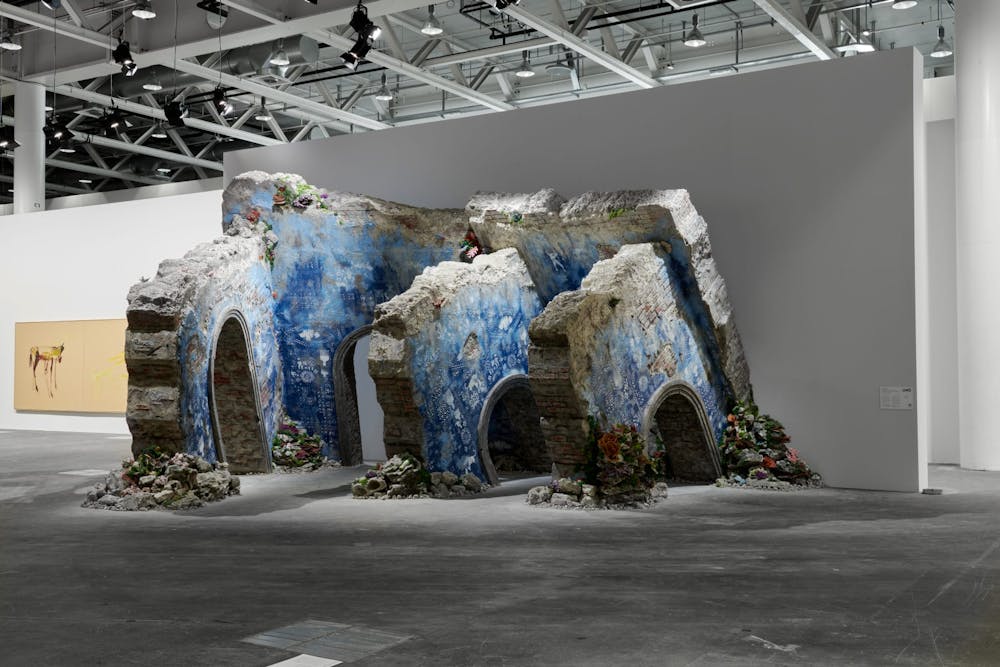
the vast ocean of all possibilities (19°36'16.9"N 72°13'07.0"W / 41°30'32.3"N 81°36'41.7"W), 2022, Firelei Baez. Courtesy of Art Basel.
The nature of the showroom is such that viewers will linger casually in front of Abdessemed’s widescreen projection before moving on. We know from recent news about the monied class and its lust for the seafloor: at Art Basel, visitors duck under the arches of Baez’s underwater city to take selfies. Casual diversion is the point. The artists’ statements are rendered with the pointless valor of a wasp trapped in a cup.
This isn’t necessarily the fault of the artists or the work. Political messages resonate best among a wider public, in a museum rather than a private showroom. Colombian artist Doris Salcedo offers an effective counterexample, with a concurrent exhibition at the Fondation Beyeler in Basel. The Foundation describes Salcedo’s large–scale installations as "reflections on loss, individual suffering and … collective grief." One commemorative work, Palimpsest, pays tribute to migrants drowned in the Atlantic and the Mediterranean. Similar calls for global justice fall flat at a trade show, where the bottom line is profit and prestige.
On the second day of previews, newspapers trumpet the most impressive sale of the previous day: an itty–bitty Louise Bourgeois spider that went for 22.5 million USD. Whenever a transaction of this scale is being considered, I’d like to think a sensible person reasons along these lines: Will this make me happy? Will I satisfy this work’s demands for appropriate care and display? Would this same purchase be undertaken by a Liberian warlord?
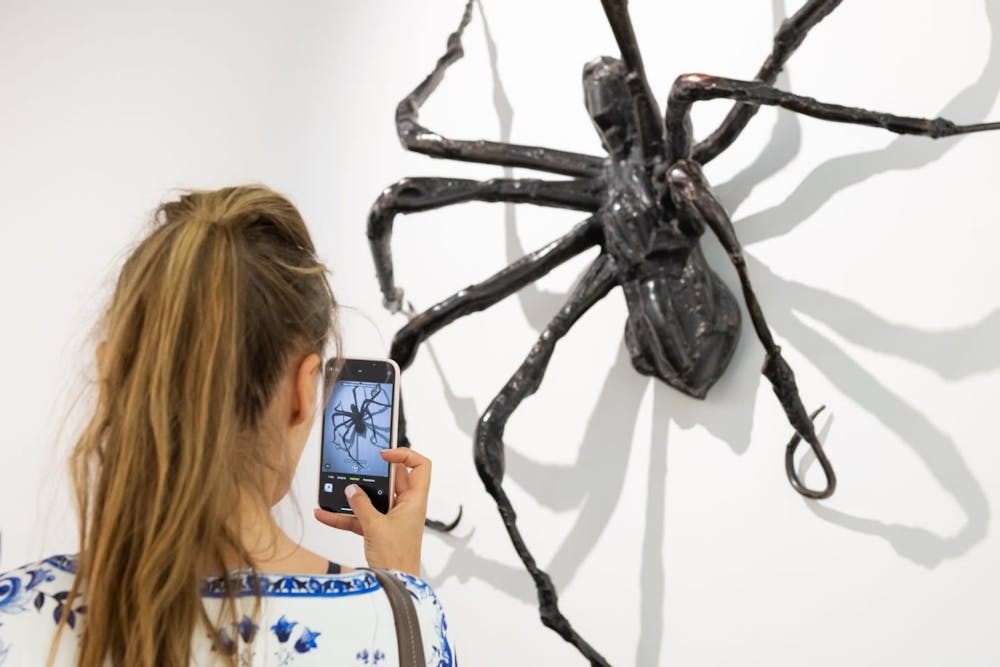
Hauser & Wirth. Courtesy of Art Basel.
Now, I’d love to stand on my soapbox and holler. I have cherished ideals. I really, really care about art for its own sake. I’m guided by beauty and artistic originality. Or that I’m with the free press. I believe in democracy and daisy fields. But instead I uncovered something profoundly disturbing about my own character: I was really, really enjoying all this.
Something about being fleeced in Basel ennobles the spirit. Consider the six CHF Americanos (the cheapest menu item in a 5–mile radius) I would top off for lunch before doddering inside to stare at this or that Basquiat. At the center of the global art market, running on caffeine, nicotine, and an insensible amount of bubbly—even my alienation feels picture perfect.
And who wouldn’t jump headfirst into the outrageous world of caviar canapés; of oligarchs quibbling over the meaning of "democracy" in the bathroom; of trim ladies queuing for the trolley with their Birkins in tow (even the Messiah walked among the lepers, after all!). The obscenity on display here renews itself without end for the simple reason that the money never runs out.
Rest assured that there’s a method to the madness. Outsiders are quick to dismiss some of these high–stakes transactions—the sale of the Kusama pumpkins, for example—as incomprehensible, absurd, an affront to good morals. But let’s zero in on why.
Art is the ground zero for the exercise of taste. Let’s be charitable and dismiss the more pragmatic reasons for art collection (generous tax deductions, resale profits, simply decoration for the home). The goodwill patron, who collects art for art’s sake, operates according to her subjective taste—similar in principle but removed from our accepted patterns of leisure consumption.
The middle class are both the most powerful and the most stringent arbiters of taste, because theirs is the most precarious position. It’s where social mobility, upwards or downwards, is the most likely. And bourgeois taste, as better minds have stated, promotes that which upholds the social edifice and censures what erodes it.
Conversely, would–be buyers at Basel are free to strip a Calder mobile or any other masterwork of its significance; doing so presents no threat or even disruption to their class position. Hence the otherwise frivolous purchase of a million–dollar pumpkin. However it looks from without, it makes perfect sense in the narrow register of the bluechip marketplace. Not so for the rest of us.
To ease my frazzled bourgeois sensibilities, I end the day in the familiar comfort of the print editions. New to this year’s fair, several publishing houses are displaying their goods, mostly glossy photo books and critical anthologies.
Because this is Art Basel, when I slip into the Taschen room, there’s a white wine reception going on. I deliberate a minute or two before grabbing a glass, then another. A middle–aged woman shoots me a look like Annie Hall’s grandma skewering Woody Allen at the dinner table. I’m tempted to stick out my tongue.
